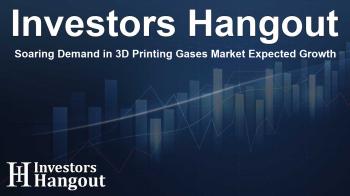Soaring Demand in 3D Printing Gases Market Expected Growth

3D Printing Gases Market Overview
As industries increasingly turn to 3D printing for manufacturing, the 3D Printing Gases Market is poised for significant growth. Currently valued at USD 56.67 million, this market is expected to reach a remarkable USD 100.33 million by 2032, with an impressive compound annual growth rate (CAGR) of 6.56% projected through the forecast period.
Growth Drivers in the 3D Printing Gases Market
One of the key factors driving this market's growth is the rising adoption of high-precision additive manufacturing technologies. The use of gases like argon and nitrogen is crucial in maintaining controlled atmospheres during the printing process, which ensures the integrity and quality of printed components. Manufacturers are increasingly demanding high-performance, defect-free products, which in turn is bolstering the need for high-purity gases specifically tailored for 3D printing.
An important trend in the industry is the shift from prototyping to mass production. This transition emphasizes the necessity of creating controlled gas environments, which is essential to prevent oxidation and contamination, particularly in sectors such as aerospace and healthcare. Here, stringent quality standards dictate that additive manufacturing must utilize gas environments effectively to ensure optimal results.
Regional Insights and Market Share
In this competitive landscape, the U.S. 3D Printing Gases Market plays a vital role, with a market size valued at approximately USD 7.54 million in 2023, capturing around 55.20% of the overall market share. The advanced manufacturing infrastructure and early adoption of additive manufacturing technologies in this region drive its growth, especially within high-value industries. Aerospace, defense, and healthcare sectors are heavily investing in metal 3D printing, and maintaining oxidation-free materials during this process through the use of inert gases is critical.
Key Players in the Market
The landscape of the 3D Printing Gases Market features several key players who contribute significantly to its dynamics. Notable companies include Air Liquide S.A., Air Products and Chemicals, Inc., and Linde PLC, all recognized for their innovations in gas solutions tailored for additive manufacturing.
Market Segmentation Overview
- By Product Type: Argon continues to dominate with a significant share of approximately 39.1%. Its inert properties make it essential in metal additive manufacturing processes, where it protects against oxidation and contamination of reactive metals.
- By Technology: Stereolithography (SLA) has led the market, commanding around 36.8% of the market share. However, new developments in technologies like Selective Laser Melting (SLM) and Direct Metal Laser Sintering (DMLS) are gaining traction.
- By Distribution: The tonnage distribution method accounts for about 38.4% of the market share, favored for its efficiency in supplying large quantities of gases vital for high-output production.
- By Application: Design and manufacturing represent the largest segment, comprising 42.9% of the market. This reflects the heavy reliance on gases to produce intricate and functional parts necessary for aerospace and automotive applications.
Recent Developments in the Industry
Recent innovations have been pivotal within the 3D printing gases industry. Companies like Linde plc and Air Products have announced significant advancements designed to meet growing demands. The launch of specialized high-purity gas solutions tailored for specific applications signifies a commitment to enhancing the additive manufacturing landscape. Additionally, partnerships, such as that between Messer Group GmbH and a European aerospace manufacturer, showcase the trend toward specialized gas mixtures optimized for additive manufacturing processes.
Challenges and Future Outlook
While the outlook for the 3D Printing Gases Market appears promising, challenges such as fluctuating material costs and the demand for consistent quality remain. As industries focus more on sustainable practices, companies are exploring environmentally friendly gas production processes to align with global sustainability goals. The continuous evolution of 3D printing technologies and increasing applications across diverse sectors suggest a flourishing future for the market.
Frequently Asked Questions
What is the current market size of the 3D Printing Gases Market?
As of now, the 3D Printing Gases Market is valued at USD 56.67 million.
What is the expected growth of the market by 2032?
The market is projected to reach USD 100.33 million by 2032.
What factors are driving growth in this market?
The growth is driven by the rising demand for high-precision additive manufacturing and the essential use of high-purity gases in the process.
Which region holds the largest share in this market?
The United States holds a significant share, reflecting its advanced manufacturing infrastructure and adoption of new technologies.
Who are the key players in the 3D Printing Gases Market?
Some key players include Air Liquide S.A., Air Products and Chemicals, Inc., and Linde PLC.
About The Author
Contact Ryan Hughes privately here. Or send an email with ATTN: Ryan Hughes as the subject to contact@investorshangout.com.
About Investors Hangout
Investors Hangout is a leading online stock forum for financial discussion and learning, offering a wide range of free tools and resources. It draws in traders of all levels, who exchange market knowledge, investigate trading tactics, and keep an eye on industry developments in real time. Featuring financial articles, stock message boards, quotes, charts, company profiles, and live news updates. Through cooperative learning and a wealth of informational resources, it helps users from novices creating their first portfolios to experts honing their techniques. Join Investors Hangout today: https://investorshangout.com/
The content of this article is based on factual, publicly available information and does not represent legal, financial, or investment advice. Investors Hangout does not offer financial advice, and the author is not a licensed financial advisor. Consult a qualified advisor before making any financial or investment decisions based on this article. This article should not be considered advice to purchase, sell, or hold any securities or other investments. If any of the material provided here is inaccurate, please contact us for corrections.

